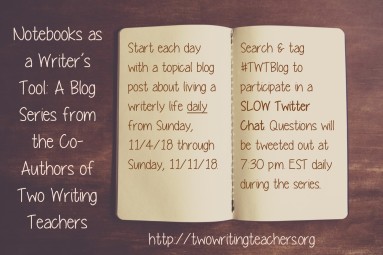
Way back in late summer, when the school year was beginning, I suspect there was a lot of energy around writer’s notebooks in your classroom. Maybe you held a decorating party where students personalized their notebooks. Maybe you made heart maps and had students write entries off of the things in their heart that were of personal significance to them. Maybe you ventured out of your classroom and captured snatches of talk in the hallways or took a neighborhood walk recording observations and wonderings. You may have spent time doing all of these things — or more — to help students understand that their lives are significant, their stories are worth recording, and their notebooks are the place to make all of that happen.
Now that it’s November, it’s possible the initial excitement for writer’s notebooks has fizzled. Perhaps your students’ notebooks feel more like a place where you tell them to write, rather than a combination of a workbench and a playground. Here are some suggestions for breathing life back into the writer’s notebook.
 Read Students’ Notebook Writing.
Read Students’ Notebook Writing.
If you want to get to know your students better as writers and people, then it helps to make space for reading their writer’s notebooks. I realize checking every student’s notebook every week can feel daunting. Check out “5 Tips for Checking Writer’s Notebooks Efficiently,” which is a post I wrote four years ago to help teachers work smarter, not harder, when reading through writer’s notebooks. Encourage students to flag — with a sticky note — no more than three entries they’d like you to read so reading their notebooks provides you with insight about them as writers and people, not a labor-intensive effort that feels like cleaning the kitchen after preparing Thanksgiving dinner.
Drop Everything and Write. Every Day.
I used Don Graves and Penny Kittle’s Quick Writes for Inside Writing to infuse life back into writer’s notebooks when I saw my fourth graders’ volume and interest in notebook writing wane. Every day, for a couple of weeks, I gave them several prompts OUTSIDE OF WRITING WORKSHOP TIME to help spark some writing. (Students were also invited to write about something of their own choosing if they didn’t like any of the prompts.) Once time was up, students shared their writing with their writing partner. It’s important to note that after a couple of weeks, I faded the prompts away, but continued to provide my students with a ten-minute period to write in their writer’s notebooks. You see, once every students’ volume increased, even the most reluctant writers were able to tap into what they already knew about generating ideas to help them put pen to paper during this time.
In Linda Rief’s new book, The Quickwrite Handbook: 100 Mentor Texts to Jumpstart Your Students’ Thinking and Writing, she defines quickwrites as “a first draft response to a short piece of writing, usually no more than one page of poetry or prose, a drawing, an excerpt from a novel or a short picture book (2018, 3). Rief asserts that “inviting students write off a found idea or borrowed line for just two to three minutes produces good writing — often really good writing” (Ibid., 2). Therefore, if you want to increase your students’ prowess as writers, try some quickwrites with them since they “allow us to write fast without censoring” (Ibid., 4).
One of the best ways to highlight the writing students craft in their writer’s notebooks is to allow students to share them during Morning Meeting. I used to allocate two share sessions each week to having students share a writer’s notebook entry. Students would sign up on the Morning Meeting Chart as they walked to the meeting area for our daily gathering. After a student shared an entry, s/he would invite “questions or comments” from the rest of the class about their writing.
Highlight Notebook Work in a Share Session.
End-of-workshop share sessions are the ideal time to showcase the ways students are using their notebooks as workbenches. As you’re conferring with students, be on the lookout for the ways they’re using their writer’s notebook as a place to think or develop meaning. You can showcase students who revised an entry based on peer feedback, grew some new thinking, cut sections of their piece (Think: Kill Your Darlings.), increased their volume, tried out a new strategy taught in a minilesson or strategy lesson, worked towards their goal, pushed themselves after studying a mentor text, etc.
Let Notebooks Leave the Classroom.
Remember when you walked around the school in the early months of the school year to capture overheard conversations? Perhaps you took a neighborhood walk to help students realize they could write about what they observed outside of school? It’s important to make time to leave the classroom to help students see that writing doesn’t have to happen within the confines of writing workshop. Let your students bring their notebooks to recess. Take a neighborhood walk and have them write about what they notice. Bring notebooks on a class field trip and provide students with time to write.
Allow Students to Bring Notebooks Home.
My views on homework have evolved since I started teaching. Over the years, I’ve read what the research says about the detriments of nightly homework in the elementary school years. In addition, as a parent of a second grader, I do not feel homework is something that needs to be heaped onto my daughter’s home life after a seven-and-a-half-hour school day. However, I do believe children should find authentic purposes for writing at home, be it journaling, maintaining a blog, or engaging in an independent writing project.
Many teachers do not send notebooks home for fear they won’t return to school. I can count — on one hand — the number of times writer’s notebooks were lost after sending them home with students. That’s because I spent a lot of time talking about the sacredness of the writer’s notebook. Sure, sometimes students would forget to bring them back to school, but that, too, was rare. Therefore, if you want students to truly live like writers, then they will need to bring their notebooks home with them so they can write outside of school hours.
What are some ways you keep notebook writing alive in your classroom? Please share your ideas by leaving a comment.
GIVEAWAY INFORMATION:
 This giveaway is for a free 20-minute classroom Skype session with author Amy Ludwig VanDerwater whose popular blog Sharing Our Notebooks is an excellent resource for notebookers of all ages and interests.
This giveaway is for a free 20-minute classroom Skype session with author Amy Ludwig VanDerwater whose popular blog Sharing Our Notebooks is an excellent resource for notebookers of all ages and interests.- For a chance to win this Skype session with Amy, please leave a comment about this or any blog post in this blog series by Sunday, November 11th at 6:00 p.m. EST. Betsy Hubbard will use a random number generator to pick the winner’s commenter number. His/her name will be announced in the ICYMI blog post for this series on Monday, November 12th.
- Please leave a valid e-mail address when you post your comment so Betsy can link you up with Amy if you win.
- If you are the winner of the Skype session, Betsy will email you with the subject line of TWO WRITING TEACHERS – AMY LV. Please respond to her e-mail with your mailing address within five days of receipt. A new winner will be chosen if a response isn’t received within five days of the giveaway announcement.



So many great ideas, Stacy. I especially like the option of sharing an entry at morning meeting. I found my Donald Graves/Penny Kittle book the other day, and purchased Linda Rief’s book. Thanks for the reminder to share with upper elementary as a way to jumpstart writing.
LikeLike
I found that Morning Meeting Share was a game changer. More kids started writing when they had an opportunity to share, in a low-risk way, outside of writing workshop.
LikeLike
When I taught 3rd grade, the kids FAVORITE homework was when I would offer invitations to write/sketch at home! Love that you have brought this back to the forefront of my thinking! Notebooks (I call them Journals) are essential to building the habits of a writer!
LikeLiked by 1 person
I think we’re winning anytime we invite kids to do things (rather than to assign) and then have them follow through.
LikeLike
I love the idea of providing students to respond to prompts outside of WW! GREAT idea!
LikeLike
Just wanted to reiterate that the prompts should be optional and can be faded away as students become more adept at self-selecting topics. Strategies like heart maps, bone maps, writing territories, “Things I Can Write About” lists, etc. can help kids have a running list of topics for this time.
LikeLiked by 1 person
Super great reminders for resuscitating writers’ notebooks. Also as a teacher, share your writing notebook. When do you write in it? What do you write in it? How do you use it “outside of school”?
LikeLike
Having a teacher who shares their own writing is a critical component to making writer’s notebooks work!
LikeLike
I love the idea of listening to conversations in the hallway-what a fun way way to gather ideas! Thank you for these tips, notebooks are such an important tool for helping students to see themselves as writers.
LikeLike
They sure are!
LikeLike